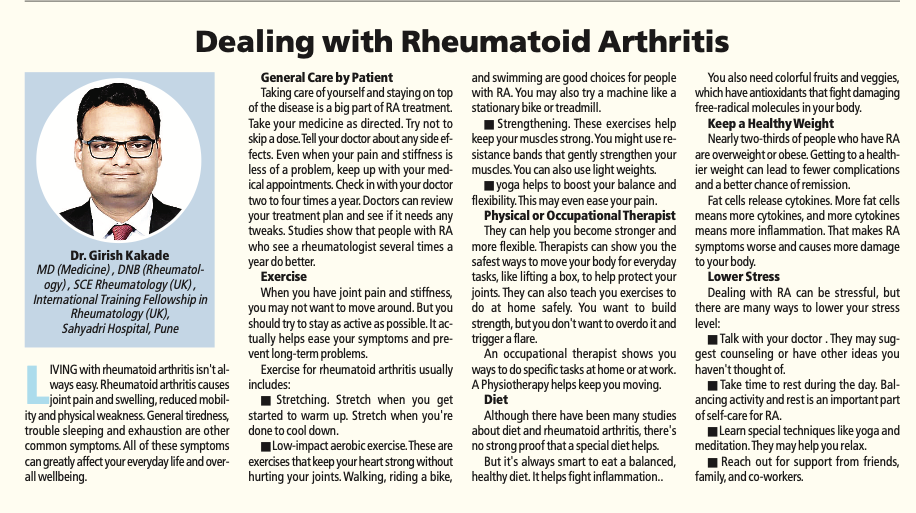
LIVING with rheumatoid arthritis isn’t always easy. Rheumatoid arthritis causes joint pain and swelling, reduced mobility, and physical weakness. General tiredness, trouble sleeping, and exhaustion are other common symptoms. All of these symptoms can greatly affect your everyday life and overall wellbeing.
General Care by Patient
Taking care of yourself and staying on top of the disease is a big part of RA treatment. Take your medicine as directed. Try not to skip a dose. Tell your doctor about any side effects. Even when your pain and stiffness are
less of a problem, keep up with your medical appointments. Check in with your doctor two to four times a year. Doctors can review your treatment plan and see if it needs any tweaks. Studies show that people with RA who see a rheumatologist several times a year do better.
Exercise
When you have joint pain and stiffness, you may not want to move around. But you should try to stay as active as possible. It actually helps ease your symptoms and prevent long-term problems.
- Exercise for rheumatoid arthritis usually includes:
Stretching. Stretch when you get started to warm up. Stretch when you’re done to cool down. - Low-impact aerobic exercise. These are exercises that keep your heart strong without hurting your joints. Walking, riding a bike, and swimming are good choices for people with RA. You may also try a machine like a
stationary bike or treadmill. - Strengthening. These exercises help keep your muscles strong. You might use resistance bands that gently strengthen your muscles. You can also use light weights.
- yoga helps to boost your balance and flexibility. This may even ease your pain.
Physical or Occupational Therapist
They can help you become stronger and more flexible. Therapists can show you the safest ways to move your body for everyday tasks, like lifting a box, to help protect your joints. They can also teach you exercises to do at home safely. You want to build strength, but you don’t want to overdo it and trigger a flare. An occupational therapist shows you ways to do specific tasks at home or at work. A Physiotherapy helps keep you moving.
Diet
Although there have been many studies about diet and rheumatoid arthritis, there’s no strong proof that a special diet helps. But it’s always smart to eat a balanced, healthy diet. It helps fight inflammation.
You also need colorful fruits and veggies, which have antioxidants that fight damaging free-radical molecules in your body.
Keep a Healthy Weight
Nearly two-thirds of people who have RA are overweight or obese. Getting to a healthier weight can lead to fewer complications and a better chance of remission. Fat cells release cytokines. More fat cells means more cytokines, and more cytokines means more inflammation. That makes RA symptoms worse and causes more damage to your body.
Lower Stress
- Dealing with RA can be stressful, but there are many ways to lower your stress
level: - Talk with your doctor. They may suggest counseling or have other ideas you haven’t thought of.
- Take time to rest during the day. Balancing activity and rest is an important part of self-care for RA.
- Lear special techniques like yoga and meditation. They may help you relax.
- Reach out for support from friends, family, and co-workers.

